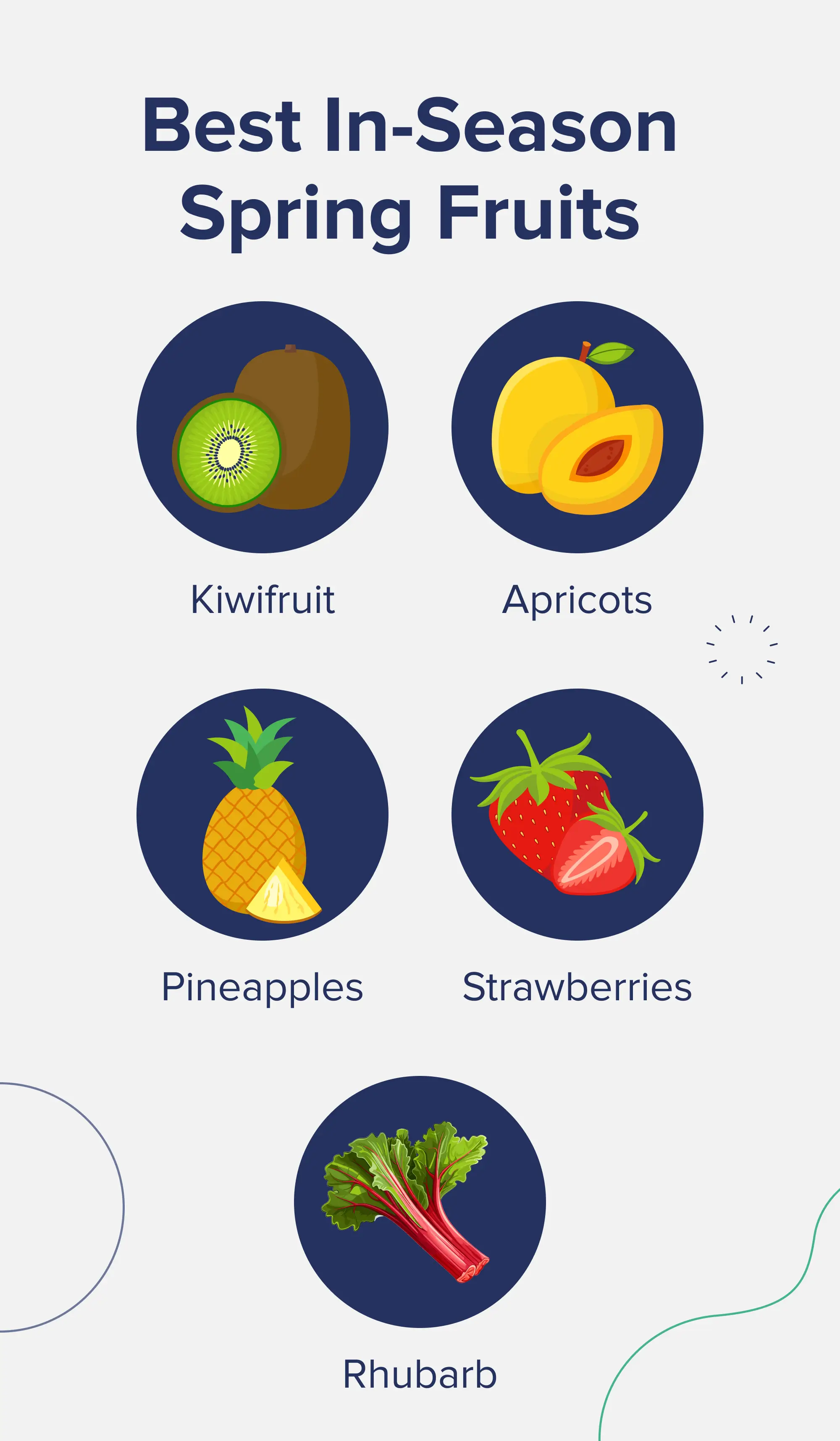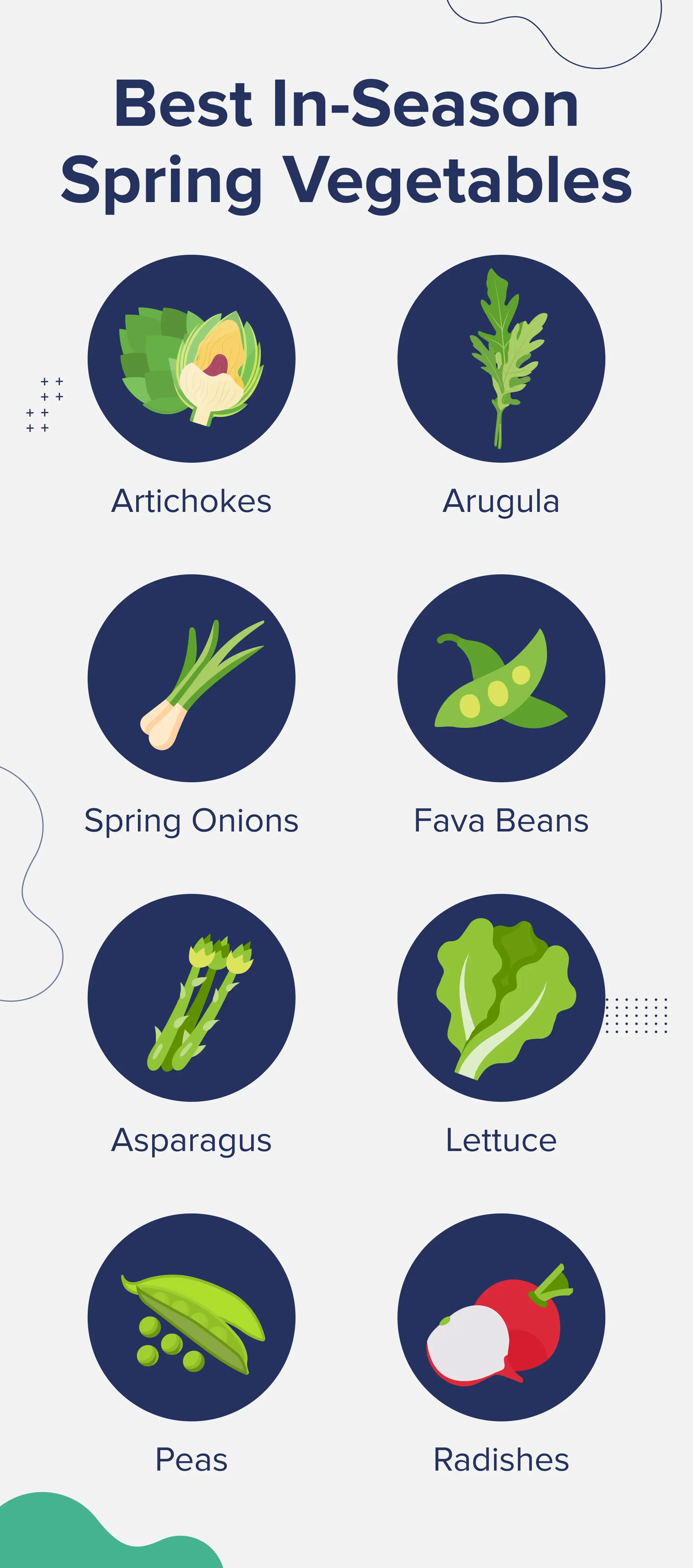Try our favorite, clean protein powder: See our top pick →
Try our favorite, clean protein powder: See our top pick →
This post contains links through which we may earn a small commission should you make a purchase from a brand. This in no way affects our ability to objectively critique the products and brands we review.
Evidence Based Research To fulfill our commitment to bringing our audience accurate and insightful content, our expert writers and medical reviewers rely on carefully curated research.
Read Our Editorial Policy
As March rolls around and the sun starts peeking out, many people ditch the root veggies and hearty soups after a long winter, looking for lighter salads and springtime produce.
But what exactly is in season during the spring?
While it can vary depending on your region of the country, check out the following list for the top in-season produce generally available during the springtime season.


Seasonal eating involves eating foods—usually fruits and vegetables—that are harvested during their peak season and consumed relatively quickly.
This approach means eating produce when it is at its maximum freshness. If you take it a step further, you can also eat locally, meaning the produce is only available during a specific time of year in your region.
Fruits, vegetables, and herbs have different growing preferences that are influenced by many environmental factors, including sunshine (both the amount of full sun per day and the strength of the sun’s rays), temperature, climate, and changes to the soil.
Because these environmental factors change season by season, some fruits and veggies grow better during warmer weather, while others are better suited for chilly, damp, or low-sun weather.
For instance, strawberries and asparagus are typically grown in the spring, while pumpkins and apples are more typical fall fare.
While seasonal eating has recently gained popularity, our ancestors have used these practices for centuries. Back then, all eating was seasonal eating—which was for necessity, really, as they couldn’t just pop into Trader Joe’s any time of year to buy fresh mango when the mood struck!
Seasonal fruits and vegetables are harvested at their peak level of ripeness, which translates to better nutritional value.
One of the top nutrients found in many fruits and vegetables is vitamin C, which degrades quickly after harvest. This means that the less time you have between harvesting and eating it, the better for maintaining vitamin C levels.
The same goes for several beneficial antioxidants—like carotenoids in carrots and squash and anthocyanins in berries, for example—which can be depleted during storage.
According to this study published in the International Journal of Food Science, plants increase the production of harmful reactive oxygen species (ROS) when they are stored after harvesting.
Greater ROS production depletes the plant’s total antioxidant stores to protect its cells—but that leaves fewer antioxidants for humans to consume and benefit from.
As many fruits and vegetables can be stored for up to a year in atmosphere-controlled conditions (or have gasses or chemicals added to extend their shelf life), you can imagine that these nutrients and antioxidants have plenty of time to degrade.
Not to mention, seasonal (and ideally local) produce simply tastes better.
If you’ve ever compared fresh-picked strawberries or tomatoes to ones from your big-box grocery store, the difference in taste is night and day.
Seasonal fruits and vegetables are grown during the times of the year when the best conditions for that specific plant exist. The right combination of sunlight, temperature, humidity, and soil quality produces the best taste.
We headed over to our in-house sustainability expert, Lexi Kassler, for her insight on how eating seasonally benefits the environment. Here’s what she had to say:
Beyond the nutritional advantages we as consumers receive when eating fruits and vegetables that are grown in season, there are also benefits for the environment—especially if you are purchasing food grown locally.
Though the globalization of our food system has economic benefits for farmers around the world—not to mention the convenience of access to any food your heart desires year-round—there are unseen environmental impacts.
Many of our favorite foods may have to make long treks to our grocery stores if we can’t grow them in-state or even in the country.
This means your favorite blueberries that come from Chile will have to take a ride on a cargo ship or a truck, emitting tons of greenhouse gases (mainly CO2) in the process.
By making the small sacrifice of eating primarily foods grown in season, and as locally as possible, you can cut down on your monetary contribution to industries negatively impacting the environment.
By no means does this solve the problem of agriculture’s contribution to climate change, but it is one small step in a marathon mission to slow down global warming.
Seasonal eating involves eating foods—usually fruits and vegetables—that are harvested during their peak season and consumed relatively quickly.
This approach means eating produce when it is at its maximum freshness. If you take it a step further, you can also eat locally, meaning fresh veggies and fruit that you eat are only available during a specific time of year in your region.
In-season produce has greater nutritional value, as certain vitamins and antioxidants have not degraded as much. Seasonal produce is also better for the environment, tastes better, and can be less costly.
All seasons are good for produce, as each season has its own set of fruits and vegetables that are grown or harvested during that time. For example, hearty root veggies, Brussels sprouts, and squashes are in season during winter, while produce like berries, lettuces, and sweet corn are at their peak in the summertime. Early spring vegetables like asparagus, radishes, and snap peas are a much-loved group of produce, as these light veggies are a welcomed change after a long winter.
If you aren’t sure what fresh produce is in season for you right now, head to your local farmers market. As farmers’ markets sell what they have just grown, you can find all sorts of fresh veggies and fruits that are local and seasonal. If you’re extra ambitious, try planting seasonal produce in your backyard or community garden. If you don’t have a backyard to start a garden, a few pots of fresh herbs (like basil, dill, cilantro, or rosemary) in a sunny spot on your windowsill are also a great place to start.
Subscribe now and never miss anything about the topics important to you and your health.